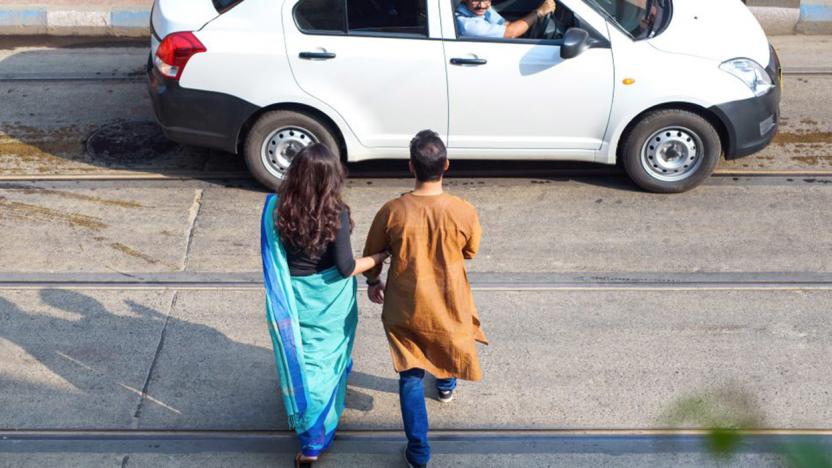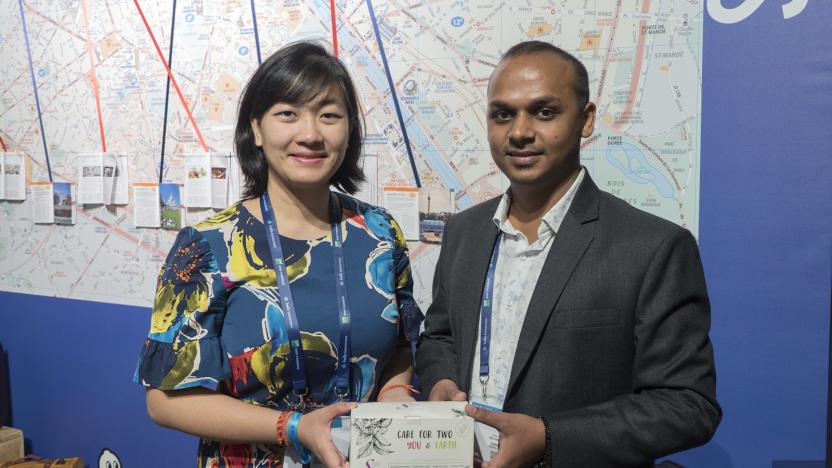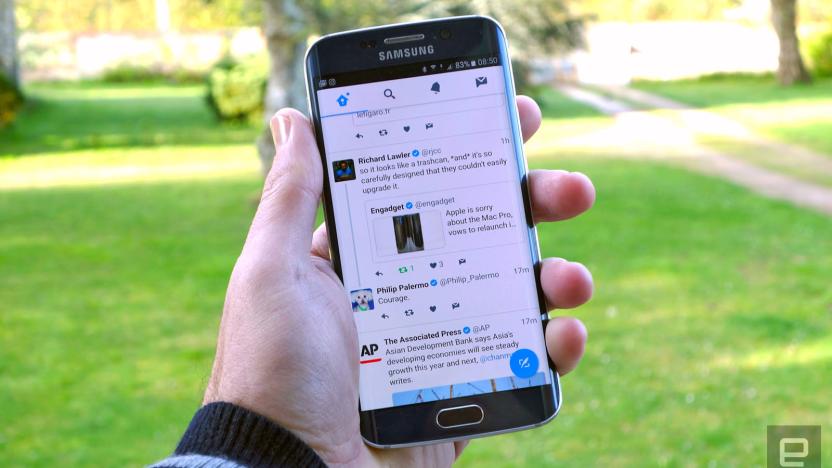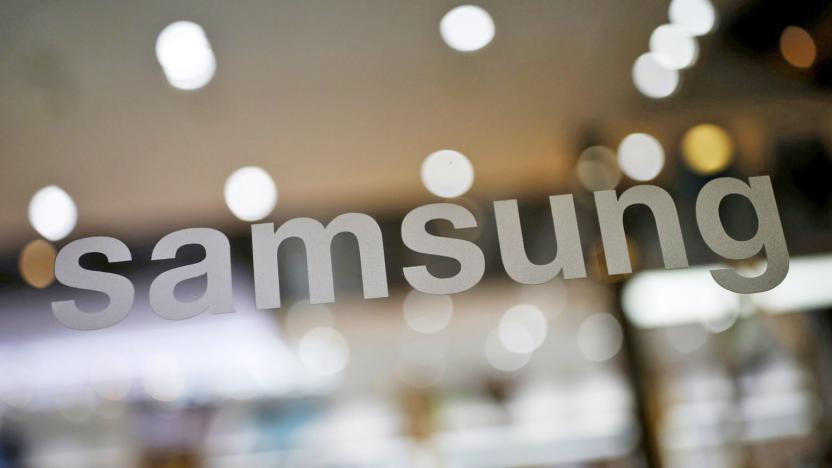DevelopingWorld
Latest

Uber launches a low-data Lite app that's just 5MB in size
Uber essentially ceded most of the Asian market after it merged with Chinese rival Didi Chuxing, but it still has a strong presence in India. To cement its position and grow further, the ridesharing firm has unveiled a new app, Uber Lite. It's less than 5MB in size, compared to over 180 MB for its regular app, works on nearly any Android (and only Android) device, and will function even if users have poor internet speeds or intermittent connectivity.

Banana fiber sanitary pads can solve big problems in India
With its sanitary pads for the Indian market, startup company Saathi solves two problems at once. Just 16 percent of women in India use them due to poverty and other reasons, which causes health and social issues. At the same time, manufacturing them wastes millions of gallons of water, and two million tons of pads end up in landfills every year. To help with all that, Saathi's pads are affordable, made from discarded banana tree fibers, manufactured in a sustainable way and 100 percent biodegradable.

Facebook's Messenger Lite expands to 100 more countries
From the text-only Facebook Zero way back in 2010, to more recent Project Aquila, Mark Zuckerberg and company have made it clear that reaching the developing world is a huge priority for the company. So there was little surprise when it announced Facebook Lite and Messenger Lite, which offer stripped-down, low-bandwidth versions of Facebook's two main products for users in emerging markets with spotty service and expensive data rates. After officially launching in just five countries last year, Facebook is now expanding the rollout of Messenger Lite to over 100 additional countries.

Twitter unveils faster Lite app for data-deprived users
Twitter is following in the footsteps of Facebook Lite and YouTube Go by launching a faster, smaller, data-saving version of its mobile website called Twitter Lite. It's aimed largely at users outside the US, UK and other nations that have fast wireless connectivity, and instead targeting emerging markets where 4G networks are sporadic or nonexistent.

Samsung launches first Exynos chip with all radios built in
Samsung has revealed a new chip that could have a ripple effect on its high-end smartphones, and will make IoT devices and smartphones for developing markets faster, slimmer and cheaper. The quad-core 7570 is the first Exynos chip to have all wireless tech, including Cat.4 LTE, WiFi, Bluetooth, FM and GNSS (GPS), built in to a single chip. It has 70 percent more performance and uses 30 percent less battery power than its predecessor, with everything squeezed into a 20 percent smaller package.

Google seeks carrier for Loon pilot program in India
Google's Project Loon has blossomed from a crazy-sounding scheme into a practical program. In fact, the company can now auto-launch a balloon in 30 minutes that will stay aloft for 100 days. For the next step, the company will run a full pilot program to provide service to a large number of actual people, and is planning on doing it in India. The company's India VP, Rajan Anandan, told the Economic Times that it will need to partner with an India-based carrier to do so. "We can't do a Loon pilot without partnering with a local telco. We're talking to a number of them."

Game changers: Egyptians and their gadgets in 2012
Is there such a thing as revolutionary technology? Many Egyptians believe there is. A year ago, they used mobile phones, social networking and banned TV channels to spread word of the protests in Tahrir Square. Hearing the news, thousands of young people risked their lives to join in and overthrow the dictator Hosni Mubarak. To mark the revolution's anniversary, Engadget caught up with five Caireans of different ages and backgrounds to find out about the gadgets they use to keep in touch with their world. For the love of freedom, democracy and at least one bar of mobile reception, please read on.

Braille-It Labeler brings low-cost printing, 'sightless construction' to the blind
It's certainly not the first Braille label printer we've seen, but Ted Moallem's Braille-It Labeler does bring notably unique element to the table -- namely, "sightless construction." Presented at this year's A Better World by Design conference, this compact device allows blind or visually impaired users to print out adhesive labels in Braille, thanks to a simple six-button design that's compatible with any Braille alphabet. Made out of relatively common materials like aluminum and steel wire, the Braille-It can also be constructed by the blind themselves -- a potentially groundbreaking development for a demographic that's too often ignored by the retail sector. Moallem, a former MIT grad student, explains: Blind people cannot depend on mainstream commercial forces to advance the cause of Braille literacy. Nearly two centuries after the invention of Braille by a blind adolescent boy, the most widely used Braille-writing tools, the slate and stylus, are quite similar to the tools used by Louis Braille himself. In the hands of the sighted, the low-cost Braille industry has stagnated. The inventor tested his label maker at a workshop last year in Katpadi, India, where blind trainees successfully taught other visually impaired users how to create their very own Braille-It. Moallem is now looking to set up similar workshops across other locations, including Senegal, Liberia and Lebanon. The ultimate goal is to empower blind consumers to create their own low-cost and potentially life-saving tools -- particularly in developing countries, which account for an estimated 90 percent of the world's blind population. If successful, Moallem's invention and ensuing campaign could provide a remarkably simple solution for a large, yet often neglected population. We certainly wish him the best of luck. Find out more at the source link below, or check out Inhabitat's extensive coverage for more images and insight.

Researchers put smartphones on a power diet, drastically improve battery life
Nokia's Asha handsets already use browser compression to reduce data costs and power consumption for customers in the developing world, but the company's Finnish neighbours over at Aalto University have taken a totally different approach. By using a network proxy to squash traffic into bursts rather than a constant bit rate, and by forcing a smartphone's modem into idle mode between each burst, the researchers claim they can cut 3G power consumption by 74 percent. Now, we're fortunate enough to be surrounded by power outlets over here, but even we could use some of that.

Intel's Skoool software brings study materials to healthcare workers in developing countries
When we consider Intel's contributions to developing nations, it's hard not to hone in on the 5 million-plus Classmate PCs it's shipped over the past four years. This time, at least, Intel is leaving the hardware part of the equation to the Lenovos and HPs of the world and focusing on the software instead. The company just announced the Skoool Healthcare Education platform, a collection of online and offline educational materials designed to help healthcare workers in developing countries better treat women and children, tackling malnutrition, vaccination, communicable diseases and childbirth safety. To be clear, Intel isn't getting into the medical content business -- it didn't write these resources but instead culled them from various third-party sources. The idea is that the company will provide the platform to governments and healthcare workers for free, forgoing what might otherwise be an opportunity to collect licensing fees. (It'll be up to local governments to work with companies like Dell to secure low-cost PCs to run the software.) For now, Intel's launching the program in Sri Lanka, where it already has a working history with the President and Minister of Health, but a rep tells us the outfit hopes to expand the program to sub-Saharan Africa, Latin America, Central Eastern Europe and parts of Asia, reaching 1 million healthcare workers by the end of 2015. [Image courtesy of Intel]

Genesi i.MX 53 netbooks, nettops to take Freescale machines deeper into the bargain basement
Back in March, Genesi announced its plans to target emerging markets by dropping the price of its Efika MX Smartbook and Smarttop machines. Those devices packed i.MX 51 CPUs, and post-cut price tags of $199 and $129, respectively. Now the San Antonio-based outfit is hinting at any even bigger price break for the developing world with the introduction of its i.MX 53 netbook PCB. According to a Genesi rep at the Freescale Technology Forum, the board, which is significantly smaller than its predecessor, is "as cheap as we can possibly make it," and will likely power even more cost efficient Genesi computers in the near future. No word on just how low Genesi is willing to go, but it's shooting for an i.MX 53 debut sometime this summer. If cheap is your thing, check out the PCB in all its glory after the break.

Nokia's promised dual-SIM handsets arrive, look strangely familiar
Well, that didn't take long. When Stephen Elop said a new dual-SIM handset would ship by the end of June, apparently he meant to say, "Right away!" Nokia has announced the first shipments of its C2-00 -- the same dual-SIM candybar we've known about for a year -- throughout India, China, and various developing regions for €45. On this C2, one of the SIM slots is accessible from the outside of the phone, making it convenient for those carrying more than two cards. Additionally, the company revealed the X1-01, a dual-SIM (and still very loud) variant of the X1-00 with a specially tuned speaker that's said not to distort too badly -- even when the volume is turned to 11. It sells for €34 and lasts 43 days on standby. Both devices feature dual-standby, which allows calls and messages to be received on both numbers without needing to switch back and forth between them. Of course, this leaves us awaiting the arrival of Nokia's dual-SIM touchscreen phone, the C2-06, but this will suffice for today. Game on, Mr. Elop.

World Bank report finds selling virtual goods in games more profitable than 'real' economy
A report commissioned by the World Bank's infoDev unit has cast fresh light on one of the more fascinating aspects of our brave new interconnected world: the virtual economy. The "third-party gaming services industry" -- where wealthy but impatient players have someone else grind away at online games for them in exchange for monetary reward -- is one of the focal points of the study, chiefly owing to it having generated revenues in the region of $3 billion in 2009 and now serving as the primary source of income for an estimated 100,000 young folks, primarily in countries like China and Vietnam. What's encouraging about these findings is that most of the revenue from such transactions ends up in the country where the virtual value is produced, which contrasts starkly with some of the more traditional international markets, such as that for coffee beans, where the study estimates only $5.5 billion of the $70 billion annual market value ever makes it back to the producing country. The research also takes an intriguing look at the emerging phenomenon of microwork, which consists of having unskilled workers doing the web's version of menial work -- checking images, transcribing bits of text, bumping up Facebook Likes (naughty!), etc. -- and could also lead to more employment opportunities for people in poorer nations. To get better acquainted with the details, check the links below or click past the break.

Vodafone announces Webbox, gives internet access to the developing world
While many of us are focused on the latest and greatest consumer tech, there are many parts of the globe still waiting for utilities we take for granted -- like electricity, running water, and access to the internet. Developing nations do have access to cellphones, however. Vodafone is keenly aware of this fact, and its latest product, the Webbox, will bring the internet to anyone with a TV and access to 2.5G or EDGE networks. The Webbox is essentially a QWERTY keyboard -- with the data hardware from a phone stuffed inside -- that connects to a TV through basic RCA cables and allows for a relatively speedy internet experience by compressing data by around 90 percent. It's dead simple to set up, as you simply plug in the RCA's and switch on the device -- an Opera Mini browser pops up on screen and allows users to start surfing the world wide web immediately. An app store, some games, and a text editor are baked into the portal, and the ability to send email and SMS messages is included is well. Vodafone is selling the device -- which comes with a 2GB SD card and 100MB of data -- in South Africa for 749 Rand ($102), with other markets and a two year contract plan to be added later this year. Check out the Webbox, and all its elegant simplicity, in the video after the break.

Yissum develops potato-powered batteries for the developing world
Researchers in Jerusalem have just announced they've developed super simple, sustainable, organic electric batteries which are powered by treated potatoes. Their findings have just been published in the Journal of Renewable and Sustainable Energy, and detail uses of the batteries in the developing world where infrastructure is lacking. The apparently highly efficient battery is made from zinc and copper electrodes and a potato slice which has been boiled. The act of boiling the potato increased the electric power around 10 fold in comparison to an untreated potato, giving it power for days, and sometimes weeks depending on the conditions. The potato batteries are also, of course, way cheaper than regular commercial cells. The technology has officially been made available free of charge to the developing world. We knew there was a reason we loved potatoes so much. The full press release is below.

Yves Behar shows off 'hackable' electric car concept for the developing world
Yves Béhar, the founder of fuseproject and the same design mind behind the OLPC and Mission One, has shown up to the Greener Gadgets conference in New York this week with a new green car design. He terms it "hackable" and "modular," with an electric base, interchangeable parts (the symmetrical back and front portions, for instance), and a flexible design for many uses. There are a lot of parallels with the OLPC project, including a direct focus on the needs and constraints of the developing world and a bit of that "XO" logo if you look closely enough. Unfortunately, there aren't many more details at the moment, and nobody's signed on to build it yet, but given Yves's track record it's not inconceivable that someone might bite. %Gallery-86509%

ZTE and OKWAP team with Intivation to deliver next generation solar devices
Let's be honest, we'd scorch the Earth to eke just one more hour of power from our superphones. Fortunately, as residents of the western world we've got plenty of juice to power all of our gadgets. Still, we can definitely see the attraction of a solar-powered cellphone meant for the peoples of developing nations living off the grid. Throw in a flashlight and you've just changed somebody's life. That's what we've got in the ZTE S316, a dead simple candybar with color display and torch. Also announced is the S101 charger with its own built-in flashlight that can be used to charge select, non-solar devices and costs just $12 to $13, maybe less on volume. The third solar device comes from China's OKWAP and is built by Inventec. The $40 GS109 (pictured above) feature phone is destined, believe it or not, to be an object of ultimate desire when slung from the neck on a lanyard as proof of ones prosperity. Spec-wise, this dual-SIM solar-powered phone packs a video camera, color display, microSD slot, MP3 player, and even Bluetooth 2.1 -- a lot of features for a solar phone. Linking the three devices is Intivations SunBoost solar conversion technology allowing the devices to charge in conditions less than ideal. The ZTE S316, for example, draws a max of about 113mA when on a call, while the solar cell pumps out about 50mA to 60mA of juice depending upon the natural lighting conditions (it even charges when cloudy). That's about two minutes of natural light exposure required for every minute of talk time to keep the device going. The solar cell on the GS109, meanwhile, produces about 70mA in direct sunlight to keep the device humming. Remember, the idea isn't to charge a phone from 0% to full but to keep a device continually charged at about 70% to 80%. Intivation is so confident in its tech that it claims to provide "a far better charging experience than anything else on the market today." Both the S316 and S101 charger will be available in April while the relatively swank GS109 will hit next month. See them all in the gallery below. %Gallery-85611%

Intel Classmate PC is not forgotten, gets Pine Trail and WiMAX overhaul
We probably pour far too much time into dissecting the latest ThinkPad model or superphone, so to balance things out here's some positive news coming out of Intel regarding its laptop distribution programme for the developing world. Still a for-profit venture, the Classmate PC project seems to have been developing rather well, which has led the chipmaker to announce it'll be overhauling the case designs and internals of the machines it has on offer. Coming later this year, the new netbook models will offer Atom N450 and N470 Pineview CPUs as well as integrated 3G and WiMAX connectivity. Yeah, that's pretty decent gear by anyone's standards, so it's no surprise that Argentina, Brazil and Turkey have signed up for a total of 426,000 units between them, adding to the two million devices already shipped globally. Maybe someone should tell the UK government about this netbook craze before it's too late.

Lenovo aims for 'rural market,' announces $199 desktop for China
Looks like Lenovo won't be the one to get left behind in the pursuit of the "poor rural Chinese market," as the firm has just announced a basic PC that it plans to sell in that neck of the woods for between $199 and $399. While there are currently "no details" with respect to processor choices or other internal hardware specifications, we do know the unit will "include a keyboard and use a buyer's television set as a monitor." Interestingly, Lenovo actually went so far as to deny assumptions that it was merely "responding to Dell's initiative," and noted that it had been selling low-cost PCs to "rural Chinese families since 2004." Of note, there was no mention of which operating system would be running the show, but considering that Microsoft just halved the retail price of Vista over in China, you just may see it vying for selection.Read - Lenovo to sell $199 PC in rural ChinaRead - Microsoft halves Vista retail price in China

Working OLPC prototype gets its close-up
We still miss the crank, and had sort of gotten used to the lime green color scheme. But we have to admit that seeing an actual working prototype of the computer from Nicholas Negroponte's One Laptop Per Child initiative beats all of the mockups we've been looking at for the past year or so. We don't have any specs (other than the fact that it's clearly running Fedora Linux), but from the looks of it, Negroponte has clearly done a decent job at making this kid-friendly. And the keyboard, while small, doesn't look a whole lot worse than the one on the new MacBook. If this puppy can be outfitted with WiFi, one of Samsung's new NAND drives and a couple of USB ports, customers from the industrial world may just order enough of them to subsidize that $100 price tag for developing countries (if Negroponte is willing to let us buy them, that is). [Via BoingBoing]Update: We also heard from a reliable source that final versions of the PCshouldprobably have a more fleshed out Red Hat build installed, and will have WiFi. We'll let you know more as we do!








